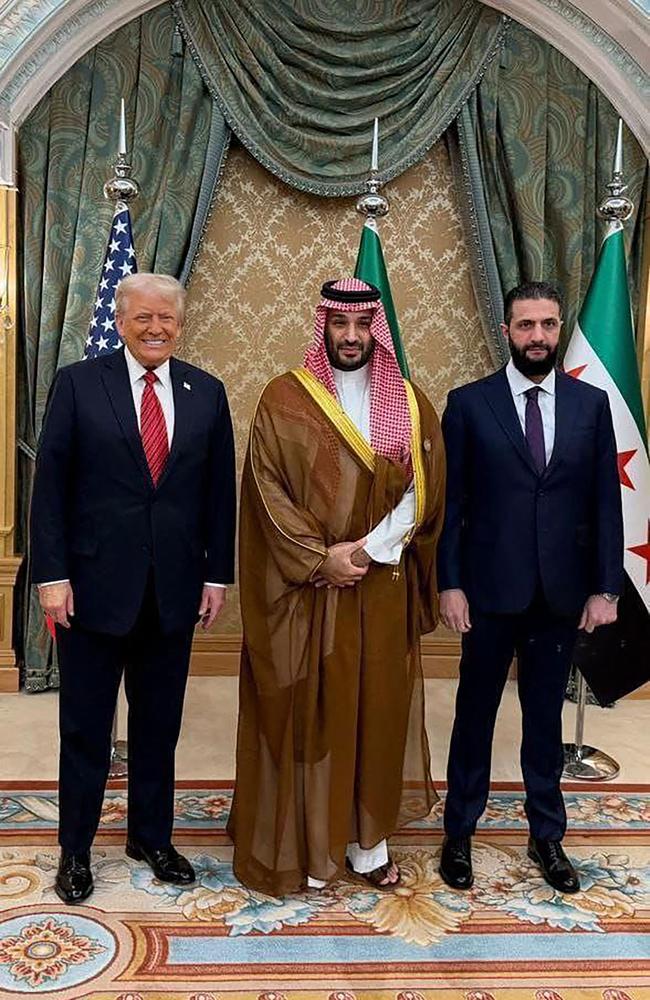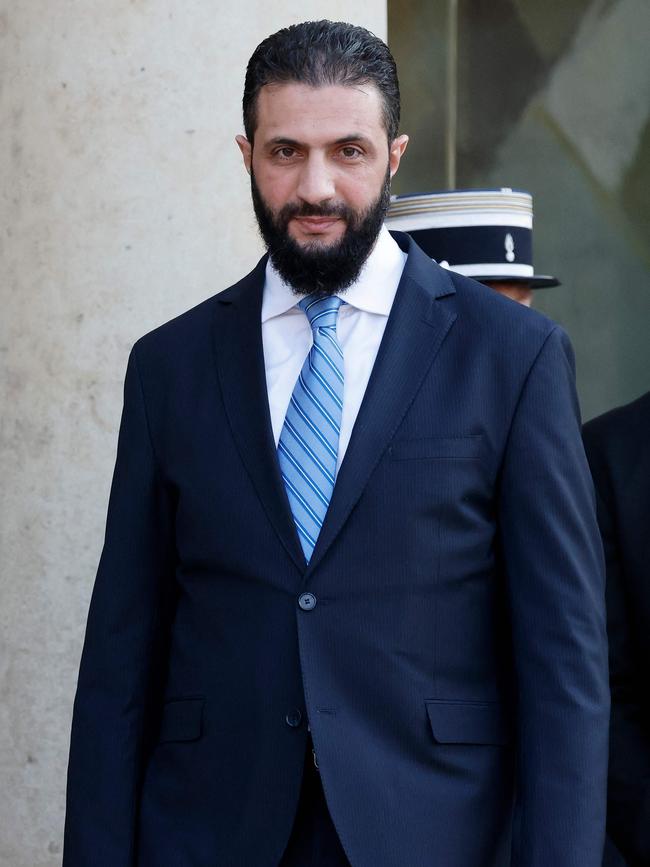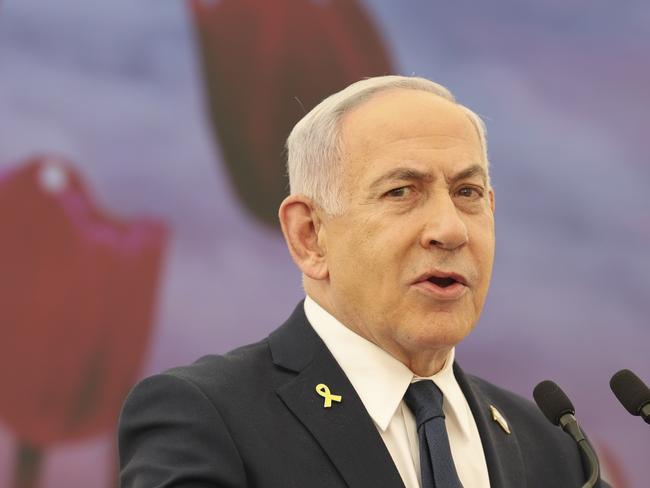No more enmity: Trump’s new doctrine of peace for the Middle East
Let’s be clear: Donald Trump, for all his faults, strode across Saudi Arabia, Qatar and the United Arab Emirates in a way that his predecessor Joe Biden never could have.
Donald Trump’s visit to the Middle East was a transformative moment that will be felt in the region for years, if not decades. Only a mercurial character such as Trump could have pulled off such an unorthodox visit, blending the pageantry and the bizarre with sweeping and substantial policy pronouncements that have up-ended a generation of traditional US diplomacy in the region.
Let’s be clear: Trump, for all his faults, strode across Saudi Arabia, Qatar and the United Arab Emirates in a way that his predecessor Joe Biden never could have.
He exuded power, embraced the unconventional, took risks, cajoled and threatened, and took his transactional ethos to new heights by declaring – in a region filled with ancient hatreds and blood feuds – that the US has “no permanent enemies”.
Can you imagine Biden suddenly lifting decades of sanctions on Syria to reward a new leader who once led a branch of al-Qa’ida?

Al Watan in Abu Dhabi on Thursday. Picture: AP
Or denouncing, as Trump did, decades of interventionist US foreign policy in the Middle East and declaring the world’s superpower no longer would be “giving you lectures on how to live”?
As Trump stormed through the region this week in a gilded display of pomp and pageantry, escorted by Arab horses, trumpets and meetings in opulent palaces, the region’s key players – especially Iran, Syria, Saudi Arabia, Israel and the Gulf states – are scrambling to work out what it all means.
In short, it was good news for Syria, Saudi Arabia and the Gulf states, potentially good news for Iran and unsettling news for Israel.
By far the most consequential and far-reaching outcome was Trump’s decision to lift all US sanctions on Syria under its new post-Assad leader, the former rebel fighter Ahmed al-Sharaa.
The move is a major gamble and surprised many given historic US hostility towards Syria, whose closest traditional allies have been Iran and Russia. But it is consistent with Trump’s willingness to embrace the unconventional, a trait that can be both a strength and a weakness.
In the case of Syria, there are good reasons for Trump to take a chance on a new relationship with a nation that, before it was gutted by 14 years of civil war and decades of dictatorship under the Assad family, was a critical powerbroker in the region.

Sharaa, an Islamist formerly aligned with Islamic State in Iraq and al-Qa’ida and who is still designated by Washington as a terrorist, did the US a huge favour by sending his ragtag group of rebels from their northwestern enclave into Damascus to overthrow the murderous Bashar al-Assad.
Since then 42-year-old Sharaa has publicly denounced violent jihadism and has set about trying to unite his fractured country while promising to protect minorities and promote a moderate brand of Islam. He has signalled a willingness to let US oil and gas companies work in the country.
His government and his leadership are still a work in progress but Trump has recognised the potential upside of a new era for Syria in which the US can help it stabilise the country, repair its economy and prevent the resurgence of Islamic State.
Trump says the move will “give them a chance at greatness” but his decision to meet face-to-face with Sharaa in Saudi Arabia – the first meeting between leaders of the two countries in 25 years – was also aimed at reminding the new Syrian leader that there are strings attached.
Above all, Trump wants Sharaa’s help in ensuring that Islamic State does not re-emerge as a threat to the stability of the region.
Trump also wants Syria to expel all foreign fighters and terrorists and for it to eventually recognise Israel.

The potential benefits for the US from a wealthier, less ideological Syria are enormous.
The civil war that began in 2011 has killed more than 600,000 people and displaced about 13 million. The war, and the sanctions against Assad, plunged the economy into the abyss. The World Bank estimated that Syria’s economy shrank by more than half between 2010 and 2020. In 2022, it estimated that an astonishing 69 per cent of Syria’s population were living in poverty.
The removal of US sanctions not only will kickstart the economy but also will set off a chain reaction because Gulf states can now potentially invest billions of dollars into Syria without violating US sanctions.
Greater US investment and trade with Syria also helps Washington minimise the influence of Syria’s traditional allies, Iran and Russia.
Sharaa says he still wants to maintain good relationships with both, but with Assad now gone the influence of Moscow and Tehran has shrunk dramatically and will continue to do so given Trump’s olive branch to Damascus.
Moscow still has an air base and a naval base in Tartus but its future is uncertain. The new regime in Syria also will end Iran’s ability to use the country to funnel military aid to its terror proxy Hezbollah in Lebanon.
Despite all of this, Trump’s bet on a new and more moderate Syria is a risk. The country has a long history of sectarian violence.
As recently as March, armed men loyal to the new Syrian interim president carried out a series of brutal killings of families from the Alawite minority on the grounds they were remnants of the former Assad regime.
Trump’s second most important outcome from the visit was the extension of an unexpected olive branch to Iran, although one that was still coated in threats.
The US President’s edict to Iran was that it was now time for its ruling mullahs to decide what sort of long-term relationship they wanted with the US.
“We’re in very serious negotiations with Iran for long-term peace,” Trump said in Doha. “And if we do that, it’ll be fantastic.”
Using a blend of carrot and stick, Trump warned Iran that it would never be allowed to have a nuclear bomb and that it soon would face “massive maximum pressure” if it did not take steps to curb its nuclear program.
He called Iran “the biggest and most destructive force” threatening the stability of the region. Yet at the same time Trump made it clear that he favoured a diplomatic solution and that he “wants to make a deal” with Iran to wind down its nuclear program in exchange for sanctions relief.
His language was not the language of a president who was eager to launch a military strike against Iran’s nuclear facilities, although he still left that option open.
The major sticking point is whether, under a new deal, Iran would be able to enrich uranium at a lower grade for civilian use. Trump has at times demanded that Iran completely dismantle its civilian nuclear program, something Tehran maintains it will never do.
But Trump has given signals he is willing to abandon his maximalist position of Iran shutting down its nuclear program if a deal can be reached in which Iran enriches uranium only at the lower levels needed for civilian use supervised by international inspectors.
A deal also would likely require Iran to get rid of its stockpiles of high enriched uranium that can be weaponised.
The International Atomic Energy Agency, the UN’s nuclear watchdog, says Iran has enriched enough uranium close to weapons-grade quality to make six nuclear bombs.
The pay-off for Iran would be the lifting of crippling US sanctions and, potentially, a once-unthinkable era of stable relations with the US.
Trump’s visit also was a graphic illustration of how his “America First” approach to foreign policy is as much about cutting business deals favourable to the US as it is about geopolitics.
In Saudi Arabia alone, Trump secured a $US600bn ($937bn) commitment from that country to invest in the US and an eye-watering $US142bn arms deal.
The warm interaction between Trump and Saudi Crown Prince Mohammed bin Salman was a notable contrast to the cool relationship the crown prince had with Biden after the Saudi royal was implicated in the murder of journalist Jamal Khashoggi at the Saudi consulate in Istanbul in 2018.
Saudi Arabia sees closer ties with Trump as a way to fast-tack its modernisation and assert its leadership in the region. Trump, who showed no interest in discussing human rights issues with the crown prince, also is hoping that closer ties will give him more leverage to persuade Saudi Arabia to consider the normalisation of relations with Israel.
Trump sees a Saudi-Israel deal as a natural extension of the historic 2020 Abraham Accords that normalised relations between Israel and the UAE and between Israel and Bahrain.
But the plan was derailed by the October 7 massacre of Israelis in 2023 and the subsequent war in Gaza, with Saudi Arabia now insisting the deal can happen only after the creation of a Palestinian state.
Still, that did not stop Trump using his new-found leverage with the Saudis to pressure the kingdom to change its mind.
“It’s my fervent hope, wish and even my dream that Saudi Arabia … will soon be joining the Abraham Accords,” Trump said before adding: “But you’ll do it in your own time.”
The most important and vexing question arising from Trump’s visit is what it means for Israel. Trump denies he gave Israel and its leader Benjamin Netanyahu the cold shoulder by choosing not to visit on this Middle East tour. He points out that the diplomacy he is conducting, with the promise of closer ties with Syria and potentially Iran, is ultimately a good thing for Israel.
But the developments this week will be unnerving for Israel on several levels.

First, it continues the recent trend of Trump distancing himself from Netanyahu on key issues in the region. Israel was taken by surprise by recent unilateral actions that Trump had taken without consulting it. These include Trump’s abrupt decision to end US attacks on the Houthi rebels in Yemen in exchange for their promise not to attack US ships – a decision made while Israel was still under Houthi fire.
The Israeli government also has been taken by surprise by the Trump administration’s growing willingness to deal directly with Hamas without Israel’s involvement. These negotiations led to the release this week of the last living US hostage, 21-year-old Edan Alexander.
Trump’s overtures to Israel’s traditional enemies Syria and Iran will make Israel feel more isolated in the region. Netanyahu has been all but itching to launch a major bombing raid on Iran’s nuclear sites and has been waiting for Trump to give the green light.
Israel’s argument is that Iran – which continues to call for the eradication of Israel – has been gravely weakened by the crippling of its terror proxies – Hezbollah in Lebanon, Hamas in Gaza – and by the collapse of its ally, the Assad regime in Syria.
What’s more, Israel severely degraded Iran’s air defences in the two attacks it conducted on Iran in 2024 so the confluence of these events means there has never been a better time for Israel to conduct major strikes to try to wipe out, or severely degrade, Iran’s nuclear program.
But Trump’s overtures to Iran this week suggest he is no longer interested in this military option and is more interested in a long-term deal with Israel’s worst enemy. Israel also will be unnerved by Trump’s unilateral lifting of sanctions with Syria. Israel does not trust the new Sharaa regime in Syria and took aggressive defensive steps just days after the fall of Assad to ensure Syria would never again pose a threat to Israel. Its wariness is well placed – the countries have fought major conflicts in three major wars: the 1948 Arab-Israeli War, the 1967 Six-Day War and the 1973 Yom Kippur War.
Soon after Assad’s fall, Netanyahu ordered Israeli ground forces into Syria, seizing Syria’s highest peak, Mount Hermon, and launching hundreds of airstrikes to destroy the remnants of Assad’s weaponry, including its chemical weapons, to ensure they could not be used by terrorists or the new regime.
So Trump’s sudden efforts to embrace the new Syria and extend an olive branch to Iran is a shock to a region where diplomacy moves at a glacial pace.
Israel will need to adjust to the new reality that a pro-Israeli president will not always act in lock-step with it. But Trump’s unpredictability and his willingness to challenge rigid thinking and conformity in the Middle East has shaken up the status quo. That is why this is likely to be remembered as the most important and consequential Middle East visit by a US president in years.


To join the conversation, please log in. Don't have an account? Register
Join the conversation, you are commenting as Logout